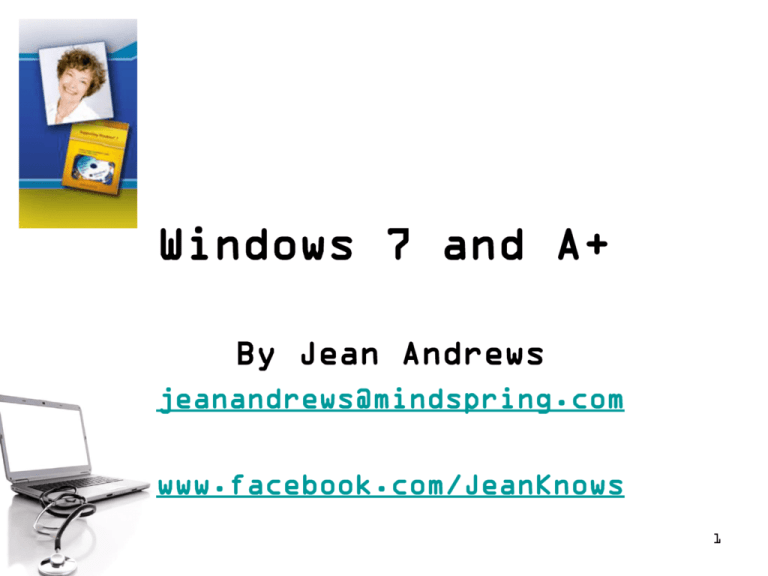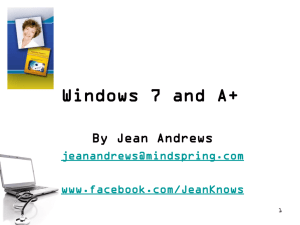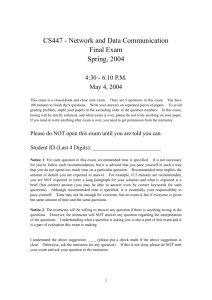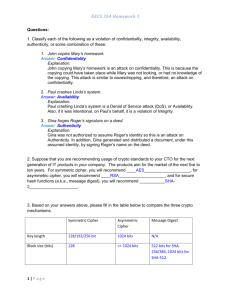Windows7_A+_Webinar
advertisement

Windows 7 and A+ By Jean Andrews jeanandrews@mindspring.com www.facebook.com/JeanKnows 1 Agenda • What’s new with Windows 7 • A+ exam changes for Windows 7 • Quick coverage of the Windows 7 A+ content 2 What’s New with Windows 7? • Better performing and less problems than Vista • Not many changes in tools and screens: – Desktop changes (Jump List, Aero Peek, Shake, and Snap) – Libraries (a collection of folders) – Windows XP Mode – Action Center (convenient location for tools) – Homegroups – Windows Live Essentials and Security Essentials – Rescue disc – Improved Backup and Restore utility 3 Editions of Windows 7 4 Windows 7 Jump List 5 Aero Peek 6 Windows 7 Libraries 7 Action Center flag in taskbar 8 Action Center Window 9 Network and Sharing Center 10 Homegroup 11 Rescue Disc • Used to launch Windows RE • Create the bootable disc using the Backup and Restore window • Three ways to launch Windows RE: – From the hard drive (press F8 at startup) – From the Windows 7 setup DVD – From the rescue disc 12 Backup and Restore 13 A+ Changes Effective Jan, 2011 2009 A+ 220-701 Essentials Exam 14 2009 A+ 220-702 Practical Application Exam 15 Microsoft Assessment and Planning (MAP) Toolkit • Software to automatically query multiple computers on the network to verify compatibility with Windows 7 before deployment • Used for lite-touch or zero-touch deployments • Recommended by Microsoft for deployments of more than 200 computers 16 User State Migration Tool (USMT) • Used to transfer user settings, application settings, and user data files to a new installation of Windows 7 • Included in the Windows Automated Installation Kit (AIK) 17 User State Migration Tool (USMT) • Order of operation: 1. Download and install the AIK software on the technician computer 2. Copy USMT program files to the source computer 3. Run ScanState command to copy data from source computer to file server 4. Install Windows 7 and apps on destination computer 5. Run LoadState command to apply from server to destination computer (USMT 4.0 uses hard-link migration to improve speed) 18 IPv6 • IPv6 address has 128 bits written in 8 blocks of hex numbers like this: – 2001:0000:0B80:0000:0000:00D3:9C5A:00CC • Four zeroes can be eliminated like this: – 2001::0B80:0000:0000:00D3:9C5A:00CC Or this: – 2001:0000:0B80::00D3:9C5A:00CC The second method is preferred 19 IPv6 continued IPv6 terms: • A link or local link is a network bounded by routers • A subnet is one or more links that have the same 64 bits in the prefix of the address • Neighbors are two or more nodes on the same link • An interface is a node’s attachment to a link 20 IPv6 continued More terms: • Using a unicast address, packets are delivered to a single node on a network • Using a multicast address, packets are delivered to all nodes on a network • An anycast address is used by routers. The closest router using the address gets the packet. 21 IPv6 continued Three kinds of unicast addresses: • A global unicast address can be used on the Internet (similar to public IP addresses) • A link-local unicast address is used on the local link (similar to private IP addresses) • A unique local unicast address is used on multiple local links within an intranet. (A hybrid between a global unicast and a linklocal unicast address, routable on the intranet but not routable on the Internet) Note: The first 48 bits or 3 blocks of a global unicast address specifies the organization’s site. (publicly leased bits from IANA) 22 IPv6 continued Interface concepts: •An IPv6 address identifies an interface, not a node •Two types of interfaces: – A physical attachment (such as a network adapter) – A logical attachment (such as a tunneling interface) •The last 64 bits or 4 blocks of an IP address identify the interface. •For a physical interface, Vista and XP use the MAC address to generate these 64 bits, but Windows 7 uses random generation. •These last 64 bits are called the interface ID. 23 IPv6 continued Parts of a global unicast address: Note: The first 48 bits or 3 blocks of a global unicast address specifies the organization’s site and is called the global routing prefix. (publicly leased bits from IANA) Global routing prefix (48 bits) Subnet ID (16 bits) Interface ID (64 bits) 24 IPv6 continued Parts of a link-local address: Example of a link-local address: FE80::9C13:4983:CCEA FE80:0:0:0 Link-local prefix (64 bits) Interface ID (64 bits) 25 IPv6 continued Parts of a unique local unicast address: FD00::/8 Unique local prefix (8 bits) Global ID within site (40 bits) Subnet ID (16 bits) Interface ID (64 bits) 26 IPv6 Address Space • Unknown address is written as :: • Loopback address is written as ::1 • For more prefixes, see the IP address space registry at www.iana.org 27 IP address assignments 28 Further Study of IPv6 • Windows 7 Resource Kit by Microsoft Press • Search the Microsoft site: – Google “Site:microsoft.com IPv6” 29 Other A+ content new to Windows 7 • Directory structures are the same as Vista • Use the exFAT file system for USB flash drives and other removable drives • exFAT is compatible with Mac OS and Linux 30 exFAT or FAT64 31 More control over the UAC box 32






